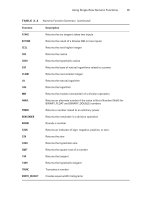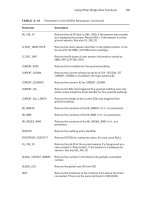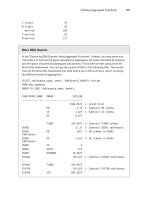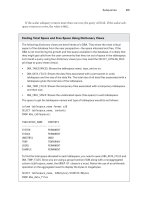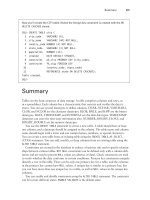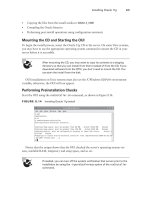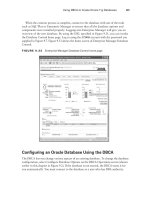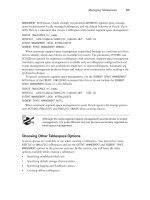Tài liệu OCA: Oracle Database 11g Administrator Certified Associate Study Guide- P20 docx
Bạn đang xem bản rút gọn của tài liệu. Xem và tải ngay bản đầy đủ của tài liệu tại đây (988.37 KB, 50 trang )
Exam Essentials
881
Know how flashback database option works. The flashback database option can greatly
reduce the time required to rewind the database to a prior point in time. Understand the
parameters associated with flashback database.
Understand backup catalog maintenance. Show how the EM Database Control interface
simplifies cataloging, crosschecking, and cleaning up.
95127c15.indd 881 2/17/09 3:01:55 PM
Please purchase PDF Split-Merge on www.verypdf.com to remove this watermark.
882
Chapter 15
N
Implementing Database Backups
Review Questions
1. Among the failure events, which is the most serious?
A. The loss of an entire redo log file group but no loss in any other group
B. The loss of one member of each redo log file group
C. The failure of the ARC0 background process
D. The failure of the LGWR background process
2. To enable the flashback database option, the database must be in which of the following
modes?
A. NOARCHIVELOG mode
B. ARCHIVELOG mode
C. FLASHBACK LOG mode
D. BEGIN BACKUP mode
3. When the database is in ARCHIVELOG mode, database recovery is possible up to which event
or time?
A. The last redo log file switch
B. The last checkpoint position
C. The last commit
D. The last incremental backup using RMAN
4. From the following, choose the true statement regarding image copies and backup sets.
A. An image copy stores one data file per image copy, and a backup set can store all data
files in a single file.
B. An image copy stores one data file per image copy, and a backup set consists of one file
per data file backed up.
C. Both image copies and backup sets use a single file to store all objects to be backed up.
D. A backup set stores each data file in its own backup file, but an image copy places all
data files into a single output file.
5. The option on the EM Database Control backup-scheduling options screen that allows you
to refresh an image copy on disk with an incremental backup is known as which RMAN
feature?
A. Incrementally updated backups
B. Incremental level-zero backups
C. Compressed image-copy refresh
D. Compressed incremental backups
95127c15.indd 882 2/17/09 3:01:55 PM
Please purchase PDF Split-Merge on www.verypdf.com to remove this watermark.
Review Questions
883
6. When should the DBA make a trace copy of the control file using ALTER DATABASE BACKUP
CONTROLFILE TO TRACE?
A. After every backup
B. After multiplexing the control files
C. Whenever restarting the instance
D. Whenever the physical structure of the database changes
7. Which of the following is not a step in configuring your database to archive redo log files?
A. Place the database in ARCHIVELOG mode.
B. Multiplex the online redo log files.
C. Specify a destination for archived redo log files.
D. Specify a naming convention for your archived redo log files.
8. Why are online backups known as inconsistent backups?
A. Because not all control files are synchronized to the same SCN until the database is
shut down
B. Because both committed and uncommitted transactions are included in a backup when
the database is online
C. Because a database failure while an online backup is in progress can leave the database
in an inconsistent state
D. Because online backups make copies of data files while they are not consistent with the
control files
9. Which parameter is used to specify the archive-log destination?
A. ARCHIVE_LOG_DEST_n
B. LOG_ARCHIVE_DEST_n
C. DB_CREATE_FILE_DEST
D. DB_RECOVERY_FILE_DEST_n
10. Which of the following initialization parameters specifies the location where the control file
trace backup is sent?
A. DIAGNOSTIC_DEST
B. BACKGROUND_DUMP_DEST
C. LOG_ARCHIVE_DEST
D. CORE_DUMP_DEST
11. Which of the following pieces of information is not available in the control file?
A. Instance name
B. Database name
C. Tablespace names
D. Log sequence number
95127c15.indd 883 2/17/09 3:01:55 PM
Please purchase PDF Split-Merge on www.verypdf.com to remove this watermark.
884
Chapter 15
N
Implementing Database Backups
12. Which data dictionary view shows that the database is in ARCHIVELOG mode?
A. V$INSTANCE
B. V$LOG
C. V$DATABASE
D. V$THREAD
13. Which file records all changes made to the database and is used only when recovering an
instance?
A. Archive-log file
B. Redo log file
C. Control file
D. Alert log file
14. Which initialization parameter contains the value used as the default for archived log file
destination 10?
A. LOG_ARCHIVE_DEST
B. STANDBY_ARCHIVE_DEST
C. LOG_ARCHIVE_DUPLEX_DEST
D. DB_RECOVERY_FILE_DEST
E. USE_DB_RECOVERY_FILE_DEST
15. Which of the following commands is a key step in multiplexing control files using an spfile?
A. ALTER SYSTEM SET CONTROL_FILES= ‘/u01/oradata/PRD/cntrl01.ctl’, ‘/u01/
oradata/PRD/cntrl02.ctl’ SCOPE=SPFILE;
B. ALTER SYSTEM SET CONTROL_FILES= ‘/u01/oradata/PRD/cntrl01.ctl’, ‘/u01/
oradata/PRD/cntrl02.ctl’ SCOPE=MEMORY;
C. ALTER SYSTEM SET CONTROL_FILES= ‘/u01/oradata/PRD/cntrl01.ctl’, ‘/u01/
oradata/PRD/cntrl02.ctl’ SCOPE=BOTH;
D. The number of control files is fixed when the database is created.
16. Which statement adds a member /logs/redo22.log to redo log file group 2?
A. ALTER DATABASE ADD LOGFILE ‘/logs/redo22.log’ TO GROUP 2;
B. ALTER DATABASE ADD LOGFILE MEMBER ‘/logs/redo22.log’ TO GROUP 2;
C. ALTER DATABASE ADD MEMBER ‘/logs/redo22.log’ TO GROUP 2;
D. ALTER DATABASE ADD LOGFILE ‘/logs/redo22.log’;
17. What is the biggest advantage of having the control files on different disks?
A. Database performance.
B. Guards against failure.
C. Faster archiving.
D.
Writes are concurrent, so having control files on different disks speeds up control file writes.
95127c15.indd 884 2/17/09 3:01:55 PM
Please purchase PDF Split-Merge on www.verypdf.com to remove this watermark.
Review Questions
885
18. To place the database into ARCHIVELOG mode, in which state must you start the database?
A. MOUNT
B. NOMOUNT
C. OPEN
D. SHUTDOWN
E. Any of the above
19. Which of the following commands places the database in ARCHIVELOG mode?
A. ALTER SYSTEM ARCHIVELOG;
B. ALTER DATABASE ARCHIVELOG;
C. ALTER SYSTEM SET ARCHIVELOG=TRUE;
D. ALTER DATABASE ENABLE ARCHIVELOG MODE;
E. ALTER DATABASE ARCHIVELOG MODE;
20. Which of the following substitution-variable formats are always required for specifying the
names of the archived redo log files? (Choose all that apply.)
A. %d
B. %s
C. %r
D. %t
95127c15.indd 885 2/17/09 3:01:55 PM
Please purchase PDF Split-Merge on www.verypdf.com to remove this watermark.
886
Chapter 15
N
Implementing Database Backups
Answers to Review Questions
1. A. Losing an entire redo log file group can result in losing committed transactions that may
not yet have been written to the database files. Losing all members of a redo log file group
except for one does not affect database operation and does not result in lost data. A mes-
sage is placed in the alert log file. The failure of LGWR or ARC0 causes an instance failure,
but you do not lose any committed transaction data.
2. B. To enable the flashback database option, the database must be in ARCHIVELOG mode.
FLASHBACK LOG mode is not a valid mode of database operation. BEGIN BACKUP mode is
used to perform hot backups without using RMAN.
3. C. In ARCHIVELOG mode, recovering the database is possible up to the last COMMIT state-
ment; in other words, no committed transactions are lost in ARCHIVELOG mode.
4. A. Image copies are duplicate data and log files in OS format. Backup sets are binary com-
pressed files in Oracle proprietary format. In addition to storing multiple data files in a
single output file, backup sets do not contain unused blocks.
5. A. Incrementally updated backups save time during a recovery operation because fewer
incremental backups need to be applied to the restored image copy.
6. D. In the rare event that all multiplexed copies of the control file are lost, having a trace
copy of the control file reduces the possibility of data loss and reduces downtime during
a recovery operation. The preferred and recommended way to back up a control file is to
enable control file autobackup using RMAN.
7. B. Although it is recommended that you multiplex your online redo log files, it is not
required to enable ARCHIVELOG mode of the database.
8. D. During an online backup, even if all data files are backed up at the same time, they are
rarely, if ever, in sync with the control file.
9. B. LOG_ARCHIVE_DEST_n specifies the archive-log location. You can configure up to 10
archive-log destinations. LOG_ARCHIVE_DEST_10 is reserved for the flash recovery area,
which is specified by the parameter DB_RECOVERY_FILE_DEST.
10. A. The trace backup is created in a subdirectory under the location specified by the
DIAGNOSTIC_DEST parameter—$DIAGNOSTIC_DEST/diag/<dbname>/<instancename>/
trace directory.
11. A. The instance name is not in the control file. The control file has information about the
physical database structure.
12. C. The V$DATABASE view in the column LOG_MODE shows whether the database is in
ARCHIVELOG mode or in NOARCHIVELOG mode.
13. B. The redo log file records all changes made to the database. The LGWR process writes the
redo log buffer entries to the redo log files. These entries are used to roll forward, or to update,
the data files during an instance recovery. Archive log files are used for media recovery.
95127c15.indd 886 2/17/09 3:01:55 PM
Please purchase PDF Split-Merge on www.verypdf.com to remove this watermark.
Answers to Review Questions
887
14. D. DB_RECOVERY_FILE_DEST points to the flash recovery area, and this is the default for
archived log-file destination number 10.
15. A. The location of the new control files is not valid until an operating-system copy is
made of the current control file to the new location(s) and the instance is restarted. The
SCOPE=SPFILE option specifies that the parameter change will not take place until a restart.
Specifying either MEMORY or BOTH causes an error, because CONTROL_FILES is not a dynamic
parameter.
16. B. When adding log-file members, specify the group number, or specify all the existing
group members.
17. B. Having the control files on different disks ensures that even if you lose one disk, you lose
only one control file. If you lose one of the control files, you can shut down the database
and copy a control file, or you can change the CONTROL_FILES parameter and restart the
database.
18. A. To put the database into ARCHIVELOG mode, the database must be in the MOUNT state; the
control files and all data files that are not offline must be available to change the database
to ARCHIVELOG mode.
19. B. You use the ALTER DATABASE ARCHIVELOG command while the database is in the MOUNT
state to enable archiving of online redo log files.
20. B, C, D. The substitution variable %d, which represents the database ID, is required only if
multiple databases share the same archive-log destination.
95127c15.indd 887 2/17/09 3:01:55 PM
Please purchase PDF Split-Merge on www.verypdf.com to remove this watermark.
95127c15.indd 888 2/17/09 3:01:55 PM
Please purchase PDF Split-Merge on www.verypdf.com to remove this watermark.
Chapter
16
Recovering the
Database
ORACLE DATABASE 11g:
ADMINISTRATION I EXAM OBJECTIVES
COVERED IN THIS CHAPTER:
Backup and Recovery Concepts
Identify the types of failure that can occur in an Oracle
database
Describe ways to tune instance recovery
Performing Database Recovery
Overview of Data Recovery Advisor
Use Data Recovery Advisor to Perform recovery (Control file,
Redo log file, and Data file)
95127c16.indd 889 2/17/09 3:03:53 PM
Please purchase PDF Split-Merge on www.verypdf.com to remove this watermark.
Oracle Database 11g makes it easy for you to recover from a
number of database failures. In Chapter 15, “Implementing
Database Backups,” I emphasized the importance of check-
points, redo log files, and archived log files to maintain a high level of availability and
recoverability. I also showed you how to use the flash recovery area and several ways to
back up your database. In this chapter, I’ll show you how to use those backups effectively
when some kind of failure inevitably occurs.
First, you’ll understand the kinds of failures that can occur in an Oracle database and
explore how they can occur because of mistakes by users or DBAs or because of hardware
or software failures that are out of your direct control. Each of these failures can require
little or no action whatsoever, as in the case of an instance failure, but at the other end of the
spectrum, a crash of the disk containing the
SYSTEM
tablespace requires a recovery effort.
To balance performance with recoverability, you will learn how to tune instance recov-
ery to minimize the amount of time Oracle will require to recover from an instance failure
while still providing a reasonable response time for ongoing transactions. In a nutshell,
your job is to increase the mean time between failures (MTBF) by providing redundant
components where possible and leveraging other Oracle high-availability features such as
Real Application Clusters (RAC) and Streams (an advanced replication technology). Hand
in hand with increasing MTBF is decreasing the mean time to recovery (MTTR) to ensure
compliance with any service-level agreements you have in place. Last, but certainly not
least, these efforts should help you minimize data loss in such a way that committed trans-
actions are never lost.
In this chapter, you will also learn the steps required to recover from the loss of both
system-critical and non-system-critical data files for databases that are operating in both
ARCHIVELOG
and
NOARCHIVELOG
modes. I’ll also show you how to recover from the loss of a
control file or a redo log file.
The Data Recovery Advisor was introduced in Oracle 11g, which automates most of the
recovery tasks and is integrated with Enterprise Manager (EM) Database Control. As with
most DBA operations in the database, EM Database Control makes many of these adminis-
tration tasks easier and less error-prone.
Understanding Types of Database Failure
Database-related failures fall into six general categories. Understanding which category a
failure belongs in will help you more quickly understand the nature of the recovery effort
95127c16.indd 890 2/17/09 3:03:53 PM
Please purchase PDF Split-Merge on www.verypdf.com to remove this watermark.
Understanding Types of Database Failure
891
you need to use to reverse the effects of the failure and maintain a high level of availability
and performance in your database. The six general categories of failures are as follows:
Statement A single database operation fails, such as a Data Manipulation Language
(DML) statement—
INSERT
,
UPDATE
, and so on.
User process A single database connection fails.
Network A network component between the client and the database server fails, and the
session is disconnected from the database.
User error An error message is not generated, but the operation’s result, such as dropping
a table, is not what the user intended.
Instance The database instance crashes unexpectedly.
Media One or more of the database files is lost, deleted, or corrupted.
In the next six sections, I’ll provide details on these failure types and suggest some pos-
sible solutions for each one. For one particular type of failure, media failure, I’ll provide
more detailed solutions for recovery later in this chapter.
Statement Failures
Statement failures occur when a single database operation fails, such as a single
INSERT
statement or the creation of a table. Table 16.1 shows the most common problems that
occur when a statement fails, along with their solutions.
TABLE 16.1 Common Problems and Solutions for When a Statement Fails
Problem Solution
Attempts to access tables without
the appropriate privileges
Provide the appropriate privileges, or create views on
the tables and grant privileges on the view.
Running out of space Add space to the tablespace, increase the user’s
quota on the tablespace, or enable resumable-space
allocation.
Entering invalid data If constraints and triggers are not in place to enforce
data integrity, entering bad data may succeed and
cause application issues. DBAs need to work with
users to validate and correct data.
Logic errors in applications Work with developers to correct program errors or
provide additional logic in the application to recover
gracefully from unavoidable errors.
95127c16.indd 891 2/17/09 3:03:53 PM
Please purchase PDF Split-Merge on www.verypdf.com to remove this watermark.
892
Chapter 16
Recovering the Database
Although granting user privileges or additional quotas within a tablespace solves many
of these problems, also consider whether there are any gaps in the user education process
that might lead to some of these problems in the first place.
User-Process Failures
The abnormal termination of a user session is categorized as a user-process failure. After
a user-process failure, any uncommitted transaction must be cleaned up. The PMON (pro-
cess monitor) background process periodically checks all user processes to ensure that the
session is still connected. If the
PMON
finds a disconnected session, it rolls back the uncom-
mitted transaction and releases all locks held by the disconnected process. Causes for user-
process failures typically fall into one of these categories:
A user closes their SQL*Plus window without logging out.
The workstation reboots suddenly before the application can be closed.
The application program causes an exception and closes before the application can be
terminated normally.
A small percentage of user-process failures is generally no cause for concern unless it
becomes chronic. A failure may be a sign that user education is lacking—for example,
training users to terminate the application gracefully before shutting down their worksta-
tion. A DBA intervention is not needed for user-process failures, but administrators must
watch for trends, and if happens too often, they need to investigate because there may be
application problems or network issues that cause an excessive number of user-process
failures. More information may be available in the alert log file showing whether the user
process is hitting a bug and whether there are any trace files written.
Network Failures
Depending on the locations of your workstation and your server, getting from your work-
station to the server over the network might involve a number of hops; for example, you
might traverse several local switches and WAN routers to get to the database. From a net-
work perspective, this configuration provides a number of points where failure can occur.
These types of failures are called network failures.
In addition to hardware failures between the server and client, a listener process on the
Oracle server can fail, or the network card on the server itself can fail. To guard against
these kinds of failures, you can provide redundant network paths from your clients to the
server, as well as additional listener connections on the Oracle server and redundant net-
work cards on the server.
User-Error Failures
Even if all your redundant hardware is at peak performance and your users have been
trained to disconnect from their Oracle sessions properly, users can still inadvertently delete
95127c16.indd 892 2/17/09 3:03:53 PM
Please purchase PDF Split-Merge on www.verypdf.com to remove this watermark.
Understanding Types of Database Failure
893
or modify data in tables or drop an index. This is known as a user-error failure. Although
these operations succeed from a statement point of view, they might not be logically correct:
the
DROP
TABLE
command worked fine, but you really didn’t want to drop that table!
If data was inadvertently deleted from a table and not yet committed, a
ROLLBACK
state-
ment will undo the damage. If a
COMMIT
has already been performed, you have a number
of options at your disposal, such as using data in the undo tablespace for a flashback query
or using data in the archived and online redo logs with the LogMiner utility, available as a
command-line interface or a graphical user interface.
You can recover a dropped table using Oracle’s recycle-bin functionality. A dropped
table is stored in a special structure in the tablespace and is available for retrieval as long as
the space occupied by the table in the tablespace is not needed for new objects. Even if the
table is no longer in the tablespace’s recycle bin, depending on the criticality of the dropped
table, you can use either tablespace point-in-time recovery (TSPITR) or flashback database
recovery to recover the table, taking into consideration the potential data loss for other
objects stored in the same tablespace for TSPITR or in the database if you use flashback
database recovery.
TSPITR and flashback database recovery are beyond the scope of this book
but are covered in more detail in OCP: Oracle Database 11g Administrator
Certified Professional Study Guide (Sybex, 2009).
If the inadvertent changes are limited to a small number of tables that have few or no
interdependencies with other database objects, flashback-table functionality is most likely
the right tool to bring back the table to a certain point in time.
Later in this chapter, in the section “Performing Recovery Operations,” I’ll show you
how to recover dropped tables from the recycle bin using the flashback drop functionality,
retrieve deleted rows from a table using the flashback query functionality, use the flashback
table functionality to bring a table back to a specific point in time along with its dependent
objects, and use LogMiner to query online and archived redo logs for the previous state of
modified rows.
The Oracle 11g database provides flashback technology, which is aimed to
recover from user errors.
Instance Failures
An instance failure occurs when the instance shuts down without synchronizing all the
database files to the same system change number (SCN), requiring a recovery operation the
next time the instance is started. Many of the reasons for an instance failure are out of your
direct control; in these situations, you can minimize the impact of these failures by tuning
95127c16.indd 893 2/17/09 3:03:53 PM
Please purchase PDF Split-Merge on www.verypdf.com to remove this watermark.
894
Chapter 16
Recovering the Database
instance recovery. You will learn how to tune instance recovery later in this chapter, in the
section “Tuning Instance Recovery.”
Here are a few causes for instance failure:
A power outage
A server-hardware failure
Failure of an Oracle background process
Emergency shutdown procedures (intentional power outage or
SHUTDOWN
ABORT
)
In all these scenarios, the solution is easy: run the
STARTUP
command, and let Oracle auto-
matically perform instance recovery using the online redo logs and undo data in the undo
tablespace. If the cause of the instance failure is related to an Oracle background-process
failure, you can use the alert log and process-specific trace files to debug the problem. EM
Database Control makes it easy to review the contents of the alert log and any other alerts
generated right before the point of failure.
Media Failures
Another type of failure that is somewhat out of your control is media failure. A media
failure is any type of failure that results in the loss of one or more database files: data files,
control files, or redo log files. Although the loss of other database-related files such as an
init.ora
file or a server-parameter file (spfile) is of great concern, Oracle Corporation does
not consider it a media failure. The database file can be lost or corrupted for a number of
reasons:
Failure of a disk drive
Failure of a disk controller
Inadvertent deletion or corruption of a database file
Following the best practices defined in Chapter 15—in other words, adequately mirroring
control files and redo log files and ensuring that full backups and their subsequent archived
redo log files are available—will keep you prepared for any type of media failure.
In the next section, I will show you how to recover from the loss of control files, data files,
and redo log files.
Performing Recovery Operations
Once the inevitable database failure occurs, you can perform a relatively quick and painless
recovery operation if you have followed the backup guidelines presented in Chapter 15 and
clearly understand the types of failures presented earlier in this chapter.
Before I show you how to perform recovery, however, it is important for you to under-
stand how an Oracle instance starts up and what kinds of failures can occur at each startup
phase. Understanding the startup phases is important, because some types of recovery
95127c16.indd 894 2/17/09 3:03:54 PM
Please purchase PDF Split-Merge on www.verypdf.com to remove this watermark.
Performing Recovery Operations
895
operations must occur in a particular phase. Once a database is started, the instance will
fail under a number of conditions that I will describe in detail.
Next, I will describe how instance recovery works and how to tune instance recovery,
and then show you ways to easily recover from several types of user errors. Finally, I will
show you how to recover from media failures due to the loss of both critical and non–system-
critical data files.
Understanding Instance Startup
Starting up a database involves several phases, from being shut down to being open and
available to users. If certain prerequisites are not present, the database startup halts, and
you must take some kind of remedial action to permit the startup to proceed. In the follow-
ing list are the four basic database states along with their prerequisites after you type the
STARTUP
command at the SQL*Plus prompt:
SHUTDOWN
No background processes are active. A
STARTUP
command is used when the
database is in this state; the
STARTUP
command fails if you are in any other state unless you
are using
STARTUP
FORCE
to restart an instance.
NOMOUNT
Also known as the
STARTED
state, the instance must be able to access the
initialization-parameter file, either as a text-based
init.ora
file or as an spfile.
MOUNT
In this state, the instance checks that all control files listed in the initialization-
parameter file are present and identical. Even if one of the multiplexed control files is
unavailable or corrupted, the instance does not enter the
MOUNT
state and stays in the
NOMOUNT
state.
OPEN
Most of the time spent in the instance startup occurs during this phase. All redo log
groups must have at least one member available, and all data files that are marked as online
must be available.
You are notified in a number of ways that a redo log group member is missing or a data
file is missing. If a data file is missing or corrupted, you will get a message while you are
running the
STARTUP
command, as in this example:
SQL> startup
ORACLE instance started.
Total System Global Area 197132288 bytes
Fixed Size 778076 bytes
Variable Size 162537636 bytes
Database Buffers 33554432 bytes
Redo Buffers 262144 bytes
Database mounted.
95127c16.indd 895 2/17/09 3:03:54 PM
Please purchase PDF Split-Merge on www.verypdf.com to remove this watermark.
896
Chapter 16
Recovering the Database
ORA-01157: cannot identify/lock data file 4 - see DBWR trace file
ORA-01110: data file 4: ‘/u05/oradata/ord/users01.dbf’
SQL>
The message in SQL*Plus shows only the first data file that needs attention. You will
have to use the dynamic performance view
V$RECOVER_FILE
to list all the files that need
attention. Here is a query against the view
V$RECOVER_FILE
and a second query joining
V$RECOVER_FILE
and
V$DATAFILE
given the previous
STARTUP
command:
SQL> select file#, error from v$recover_file;
FILE# ERROR
---------- ---------------------------------------------
4 FILE NOT FOUND
11 FILE NOT FOUND
SQL> select file#, name from
2 v$datafile join v$recover_file using (file#);
FILE# NAME
---------- ----------------------------------------
4 /u05/oradata/ord/users01.dbf
11 /u08/oradata/ord/idx02.dbf
SQL>
If a data file is offline or taken offline, the instance can still start as long as the data file
does not belong to the
SYSTEM
or
UNDO
tablespace. Once the instance is started, you can
proceed to recover the missing or corrupted data file and subsequently bring it online. If all
files are available but out of sync, automatic instance recovery is performed as long as the
online redo log files can bring all data files to the same SCN. Otherwise, media recovery is
required using archived redo log files.
If a redo log group member is missing, a message is generated in the alert log, but the
database will still open.
Keeping an Instance from Failing
Media failures are not always critical, depending on which type of data file is lost. If any of
the multiplexed copies of the control file are lost, an entire redo log group is lost, or any data
file from the
SYSTEM
or
UNDO
tablespace is lost, the instance will fail.
In some cases, the instance becomes unavailable to users but will not shut down; in this
case, you can use
SHUTDOWN
ABORT
to force the instance to shut down without resynchroniz-
ing the data files with the control file. The next time the instance is started, instance recov-
95127c16.indd 896 2/17/09 3:03:54 PM
Please purchase PDF Split-Merge on www.verypdf.com to remove this watermark.
Performing Recovery Operations
897
ery will be performed. If you plan on starting up the instance right after using
SHUTDOWN
ABORT
, you can instead use
STARTUP
FORCE
as shorthand for a
SHUTDOWN
ABORT
and a
STARTUP
.
Later in this chapter, I will show you how to recover from the loss of a con-
trol file, a redo log file member, or one or more data files.
Recovering from Instance Failure
As I discussed earlier, in the section “Instance Failures,” an instance failure is any kind of
failure that prevents the synchronization of the database’s data files and control files before
the instance is shut down.
Oracle automatically recovers from instance failure during instance recovery. Instance
recovery is initiated by simply starting up the database with the
STARTUP
command.
Instance recovery is also known as crash recovery.
During a
STARTUP
operation, Oracle first attempts to read the initialization file, and then
it mounts the control file and attempts to open the data files referenced in the control files.
If the data files are not synchronized, instance recovery is initiated.
Instance recovery occurs in phases:
Phase 1 Find data files that are out of sync with the control file.
Phase 2 Use the online redo log files to restore the data files to the state before instance
failure in a rollforward operation. After the rollforward, data files have committed and
uncommitted data.
Phase 3 Open the database. Once the rollforward operation completes, the database is
open to users.
Phase 4 Oracle then uses the undo segments to roll back any uncommitted transactions. The
rollback operation uses data in the undo tablespace; without a consistent undo tablespace,
the rollback operation cannot succeed. After the rollback phase, the data files contain only
committed data.
Tuning Instance Recovery
Before a user receives a “Commit complete” message, the new or changed data must be
successfully written to a redo log file. At some point in the future, the same information
must be used to update the data files; this operation usually lags behind the redo log file write
because sequential writes to the redo log file are by nature faster than random writes to one
or more data files on disk.
95127c16.indd 897 2/17/09 3:03:54 PM
Please purchase PDF Split-Merge on www.verypdf.com to remove this watermark.
898
Chapter 16
Recovering the Database
As I discussed in Chapter 15, checkpoints keep track of what still needs to be written
from the redo log files to the data files. Any transactions not yet written to the data files are
at an SCN after the last checkpoint.
The amount of time required for instance recovery depends on how long it takes to bring
the data files up-to-date from the last checkpoint position to the latest SCN in the control
file. To prevent performance problems, the distance between the checkpoint position and
the end of the redo log group cannot be more than 90 percent of the size of the redo log
group.
You can tune instance recovery by setting an MTTR target, in seconds, using the initial-
ization parameter
FAST_START_MTTR_TARGET
. The default value for this parameter is zero;
the maximum is 3,600 seconds (1 hour).
A setting of zero disables the target, which reduces the likelihood of redo logs waiting
for writes to the data files. However, if
FAST_START_MTTR_TARGET
is set to a low nonzero
value, writes to the redo logs most likely have to wait for writes to the data files. Although
this reduces the amount of time it takes to recover the instance in the case of an instance
failure, it affects performance and response time. Setting this value too high can result in
an unacceptable amount of time needed to recover the instance after an instance failure.
Two other parameters control instance recovery time:
LOG_CHECKPOINT_TIMEOUT
This is the maximum number of seconds that any new or modi-
fied block in the buffer cache waits until it is written to disk.
FAST_START_IO_TARGET
This is similar to
FAST_START_MTTR_TARGET
, except that the recov-
ery operation is specified as the number of I/Os instead of the number of seconds to finish
instance recovery.
Setting either of these parameters overrides
FAST_START_MTTR_TARGET
. As part of the
enhanced manageability features introduced with Oracle9i, setting
FAST_START_MTTR_TARGET
is the easiest and most straightforward way to define your database’s recovery time given
the time-based constraints included in most typical SLAs.
The EM Database Control interface makes it easy to adjust
FAST_START_MTTR_TARGET
.
On the Availability screen of Database Control, choose Recovery Settings. Figure 16.1
shows the Instance Recovery setting, which you can find in the top section of the Recovery
Settings screen.
FIGURE 16.1 Adjusting MTTR for instance recovery
95127c16.indd 898 2/17/09 3:03:54 PM
Please purchase PDF Split-Merge on www.verypdf.com to remove this watermark.
Performing Recovery Operations
899
Enter the desired value using seconds or minutes. When you click the Apply button, the
new value for
FAST_START_MTTR_TARGET
goes into effect immediately and stays in effect
when the instance is restarted.
Using the SQL*Plus command line, you can accomplish this task by using the
ALTER
SYSTEM
command, as in this example:
SQL> alter system set fast_start_mttr_target=60 scope=both;
System altered.
Using
SCOPE=BOTH
, the new value of the parameter takes effect immediately and stays in
effect the next time the instance is restarted.
Recovering from User Errors
Earlier in this chapter, in the section “User-Error Failures,” you learned a number of sce-
narios in which a user’s data was inadvertently changed or deleted or a table was dropped.
In the following sections, you’ll learn quite a few helpful tasks, such as how to do the
following:
Use flashback query to retrieve selected rows from a previous state of a table
Recover a table using flashback drop and a tablespace’s recycle bin
Bring an entire table and its dependent objects (such as indexes) back to a specific point
in time using flashback table
Roll back a specific transaction and its dependent transactions using flashback
transaction
Query previous transactions in the online and archived redo logs using the LogMiner
utility
Using Flashback Query
One of the features introduced in Oracle9i was called flashback query. It allows a user to
“go back in time” and view the contents of a table as it existed at some point in the recent
past. A flashback query looks a lot like a standard SQL
SELECT
statement, with the addition
of the
AS
OF
TIMESTAMP
clause.
Before users can take advantage of the flashback query feature, you, the DBA, must per-
form two tasks:
Make sure there is an undo tablespace in the database that is large enough to retain
changes made by all users for a specified period of time. This is the same tablespace
that is used to support
COMMIT
and
ROLLBACK
functionality (discussed in Chapter 13,
“Managing Data and Undo”).
Specify how long the undo information will be retained for use by flashback queries
by using the initialization parameter
UNDO_RETENTION
. This parameter is specified in
seconds; therefore, if you specify
UNDO_RETENTION=172800
(default is 900), the undo
information for flashback queries can be available for up to two days.
95127c16.indd 899 2/17/09 3:03:54 PM
Please purchase PDF Split-Merge on www.verypdf.com to remove this watermark.
900
Chapter 16
Recovering the Database
The key to the flashback query functionality is using the
AS
OF
TIMESTAMP
clause in the
SELECT
statement; you can specify the timestamp as any valid expression that evaluates to a
date or timestamp value. In the following example, you want to query the
EMPLOYEES
table
as it existed 15 minutes ago:
SQL> SELECT employee_id, last_name, email
FROM hr.employees
AS OF TIMESTAMP (systimestamp - interval ‘15’ minute)
WHERE employee_id = 101;
EMPLOYEE_ID LAST_NAME EMAIL
----------- --------------------- -------------------
101 Kochhar NKOCHHAR
You can just as easily specify an absolute time of day to retrieve the contents of the row
at that time, as in this example:
SQL> SELECT employee_id, last_name, email
FROM hr.employees
AS OF TIMESTAMP
(to_timestamp (‘01-Sep-04 16:18:57.845993’,
‘DD-Mon-RR HH24:MI:SS.FF’))
WHERE employee_id = 101;
EMPLOYEE_ID LAST_NAME EMAIL
----------- --------------------- -------------------
101 Kochhar NTKOCHHAR
If your flashback query requires undo data that is no longer available in the undo
tablespace, you will receive an error message:
SQL> SELECT employee_id, last_name, email
FROM hr.employees
AS OF TIMESTAMP (systimestamp - interval ‘10’ month)
WHERE employee_id = 101;
select employee_id, last_name, email
*
ERROR at line 1:
ORA-08180: no snapshot found based on specified time
95127c16.indd 900 2/17/09 3:03:54 PM
Please purchase PDF Split-Merge on www.verypdf.com to remove this watermark.
